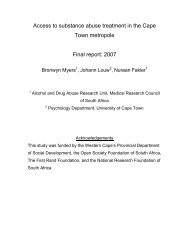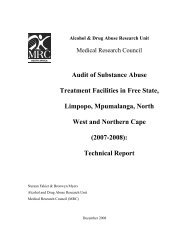Annexures 5 - SA HealthInfo
Annexures 5 - SA HealthInfo
Annexures 5 - SA HealthInfo
You also want an ePaper? Increase the reach of your titles
YUMPU automatically turns print PDFs into web optimized ePapers that Google loves.
Annexure 22a<br />
Management algorithm for seizure:<br />
Part I<br />
EVALUATION<br />
• Recurrent movement of a part of the body (eg. finger,<br />
hand, face, etc.) without loss of consciousness?<br />
• Loss of consciousness followed by rhythmic contraction<br />
of muscles?<br />
• Tongue biting?<br />
• Urinary or fecal incontinence?<br />
• Headache, confusion, drowsiness, or amnesia<br />
immediately after the event?<br />
• Sensory disturbances (numbness, dizziness, auditory or<br />
visual hallucinations)?<br />
• Psychotic changes (psychosis, hallucinations,<br />
sensations of fear or anger, etc?)<br />
No<br />
OBSERVATION<br />
Yes<br />
Are there other likely causes?<br />
(eg. syncope, transient ischemic attack, migraine, pseudoseizure<br />
Yes<br />
TREAT OTHER CAUSE<br />
No<br />
If recurrence despite appropriate treatment<br />
Step 1 • Rule out other likely causes (eg. meningitis, encephalitis, illegal drug use, alcohol<br />
withdrawal, hypoglycemia, hyper- or hyponatremia, hyper- or hypocalcemia, cerebrovascular<br />
accident, space-occupying lesion)<br />
Step 2 • Consider neurology consultation. In general, clinical evaluation is sufficient unless suspicion<br />
for infectious, malignant, vascular or metabolic cause is high. Consider checking blood<br />
chemistry and laboratory tests (serum liver test, urea, creatinine, glucose, electrolytes,<br />
calcium, anti-epileptic levels, HIV serology, alcohol and toxic substance screening)<br />
Step 3 • Treat any suspected causes of seizure<br />
Step 4 • Even if there is underlying condition (eg. history of previous stroke, epilepsy, substance<br />
abuse), aggravating triggers should be considered. For instance, subtherapeutic levels of<br />
anti-seizure drugs (which can be caused by drug-drug interactions between anti-seizure<br />
drugs and anti-tuberculosis drugs), sleep deprivation, recent alcohol ingestion, as well as<br />
anti-tuberculosis drugs may lower seizure threshold. Additionally, patients without predisposing<br />
conditions may present with first-time seizures due to anti-tuberculosis drugs<br />
alone. Therefore, aggressive treatment of seizures in patients receiving anti-tuberculosis<br />
drugs known to cause seizures is recommended.<br />
Continued:<br />
Part II

















